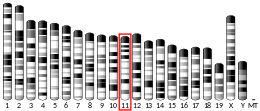GJC2
Gap junction gamma-2 (GJC2), also known as connexin-46.6 (Cx46.6) and connexin-47 (Cx47) and gap junction alpha-12 (GJA12), is a protein that in humans is encoded by the GJC2 gene.[5]
Function
This gene encodes a gap junction protein. Gap junction proteins are members of a large family of homologous connexins and comprise 4 transmembrane, 2 extracellular, and 3 cytoplasmic domains. This gene plays a key role in central myelination and is involved in peripheral myelination in humans.[5]
Clinical significance
Homozygous or compound heterozygous defects in this gene are the cause of autosomal recessive Pelizaeus-Merzbacher-like disease-1.[5]
Heterozygous missense mutations in this same gene cause pubertal onset hereditary lymphedema.
References
- GRCh38: Ensembl release 89: ENSG00000198835 - Ensembl, May 2017
- GRCm38: Ensembl release 89: ENSMUSG00000043448 - Ensembl, May 2017
- "Human PubMed Reference:". National Center for Biotechnology Information, U.S. National Library of Medicine.
- "Mouse PubMed Reference:". National Center for Biotechnology Information, U.S. National Library of Medicine.
- "Entrez Gene: gap junction protein".
Further reading
- Ostergaard P, Simpson MA, Brice G, et al. (2011). "Rapid identification of mutations in GJC2 in primary lymphoedema using whole exome sequencing combined with linkage analysis with delineation of the phenotype" (PDF). J. Med. Genet. 48 (4): 251–5. doi:10.1136/jmg.2010.085563. PMID 21266381.
- Odermatt B, Wellershaus K, Wallraff A, et al. (2003). "Connexin 47 (Cx47)-deficient mice with enhanced green fluorescent protein reporter gene reveal predominant oligodendrocytic expression of Cx47 and display vacuolized myelin in the CNS". J. Neurosci. 23 (11): 4549–59. doi:10.1523/JNEUROSCI.23-11-04549.2003. PMC 6740816. PMID 12805295.
- Menichella DM, Goodenough DA, Sirkowski E, et al. (2003). "Connexins are critical for normal myelination in the CNS". J. Neurosci. 23 (13): 5963–73. doi:10.1523/JNEUROSCI.23-13-05963.2003. PMC 6741267. PMID 12843301.
- Salviati L, Trevisson E, Baldoin MC, et al. (2007). "A novel deletion in the GJA12 gene causes Pelizaeus-Merzbacher-like disease". Neurogenetics. 8 (1): 57–60. doi:10.1007/s10048-006-0065-x. PMID 17031678.
- Ferrell RE, Baty CJ, Kimak MA, et al. (2010). "GJC2 missense mutations cause human lymphedema". Am. J. Hum. Genet. 86 (6): 943–8. doi:10.1016/j.ajhg.2010.04.010. PMC 3032064. PMID 20537300.
- Uhlenberg B, Schuelke M, Rüschendorf F, et al. (2004). "Mutations in the gene encoding gap junction protein alpha 12 (connexin 46.6) cause Pelizaeus-Merzbacher-like disease". Am. J. Hum. Genet. 75 (2): 251–60. doi:10.1086/422763. PMC 1216059. PMID 15192806.
- Orthmann-Murphy JL, Salsano E, Abrams CK, et al. (2009). "Hereditary spastic paraplegia is a novel phenotype for GJA12/GJC2 mutations". Brain. 132 (Pt 2): 426–38. doi:10.1093/brain/awn328. PMC 2640216. PMID 19056803.
- Wang J, Wang H, Wang Y, et al. (2010). "Two novel gap junction protein alpha 12 gene mutations in two Chinese patients with Pelizaeus-Merzbacher-like disease". Brain Dev. 32 (3): 236–43. doi:10.1016/j.braindev.2009.03.013. PMID 19423250.
- Henneke M, Combes P, Diekmann S, et al. (2008). "GJA12 mutations are a rare cause of Pelizaeus-Merzbacher-like disease". Neurology. 70 (10): 748–54. doi:10.1212/01.wnl.0000284828.84464.35. PMID 18094336.
- Orthmann-Murphy JL, Enriquez AD, Abrams CK, Scherer SS (2007). "Loss-of-function GJA12/Connexin47 mutations cause Pelizaeus-Merzbacher-like disease". Mol. Cell. Neurosci. 34 (4): 629–41. doi:10.1016/j.mcn.2007.01.010. PMC 1937038. PMID 17344063.
- Ruf N, Uhlenberg B (2009). "Analysis of human alternative first exons and copy number variation of the GJA12 gene in patients with Pelizaeus-Merzbacher-like disease". Am. J. Med. Genet. B Neuropsychiatr. Genet. 150B (2): 226–32. doi:10.1002/ajmg.b.30792. PMID 18521858.
- Wolf NI, Cundall M, Rutland P, et al. (2007). "Frameshift mutation in GJA12 leading to nystagmus, spastic ataxia and CNS dys-/demyelination". Neurogenetics. 8 (1): 39–44. doi:10.1007/s10048-006-0062-0. PMID 16969684.
- Ishikawa T, Sato K, Shimazaki R, et al. (2010). "[A case of autosomal recessive hypomyelinating leukodystrophy without GJA12 mutation presenting a novel phenotype]". Rinsho Shinkeigaku. 50 (1): 7–11. doi:10.5692/clinicalneurol.50.7. PMID 20120347.
This article incorporates text from the United States National Library of Medicine, which is in the public domain.



